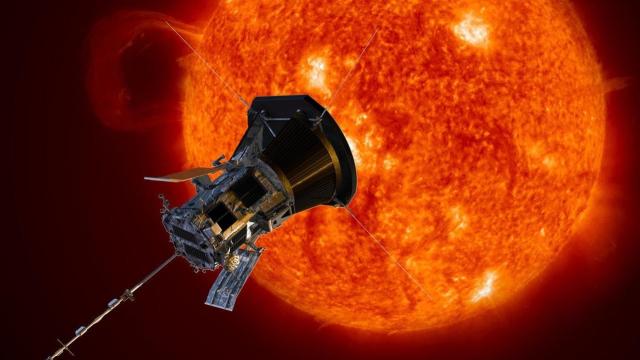Although the Sun fuels life on our planet, Earth’s host star is not to be messed with. The inflamed ball of hot gas can often times get violent, flinging streams of plasma in our direction in the form of solar wind. By the time this solar wind reaches us, it has already travelled 93 million miles and interacted with Earth’s own magnetic field. What scientists really needed, however, was to get a closer look at what’s driving solar wind from the Sun’s burning surface.
Luckily, a car-sized spacecraft has had several close encounters with the Sun. NASA’s Parker Solar Probe is designed to reach a distance of around 4 million miles from the Sun’s surface, closer than any other spacecraft has gone before. During a recent solar encounter, the probe flew through jets of highly-energetic material with a specific, fixed pattern that was linked to the Sun’s magnetic field. By measuring the data, a team of scientists traced the origins of solar wind all the way down to the surface of the Sun.
“As Parker got closer to the Sun, they started seeing a lot more structure in the wind,” James Drake, a professor at the University of Maryland, and co-author of a new study published Wednesday in Nature, told Gizmodo in a phone interview. “You’d see high velocity wind with lots and lots of bursts and then it would sort of die down a little bit, and then you’d see it getting stronger again with many more bursts.”
The new study suggests that solar wind is produced by the process of magnetic reconnection, which is when oppositely directed magnetic fields pass one another through these funnels, moving in and out of the surface of the Sun. Through this process, magnetic fields often break and then reconnect, slinging charged particles away from the Sun. “If you have two magnetic fields pointing in opposite direction, they annihilate each other…and that releases magnetic energy which produces energetic particles,” Drake explained.
The team behind the new study was able to pinpoint not just the origin of solar wind, but rather the driver that’s producing the energy on the Sun’s surface. On its own, the plasma would not be able to escape the Sun, as it doesn’t have enough energy to counter the star’s gravitational force. If it’s accelerated enough, however, through the process of magnetic reconnection, then that’s enough to drive the wind outwards such that it’s able to escape the Sun’s surface.
“Most of what we know about the Sun comes from different kinds of light,” Stuart Bale, a professor of physics at the University of California, and lead author of the new study, told Gizmodo in a phone interview. “But that only tells a part of the story.” Scientists need spacecraft like Solar Probe to be able to measure the Sun’s magnetic fields locally rather than starting at the star with a camera.
“That’s what Solar Probe has really given us as we’re flying right into the corona,” Bale added. “It’s a heroic piece of thermal engineering.”
The NASA spacecraft, launched on August 12, 2018, is designed to plunge right through the Sun’s atmosphere. It’s not an easy feat as the Sun’s surface temperatures can reach more than 5,500 Celsius, while its atmosphere can reach temperatures 300 times hotter. The Solar probe is equipped with a 4.5-inch-thick carbon-composite heat shield that can withstand temperatures up to 1,377 Celsius, according to NASA.
“There’s an enormous amount of heat at the front and behind that — the temperature goes down to 40 Celsius or something,” Bale said. “It’s like a hot afternoon in Athens.”
The Solar Probe has performed 15 solar encounters thus far, with the next one coming up on June 22. Each close encounter lasts for around 12 days, in which the probe has thus far reached 12 solar radii from the surface of the Sun, before the spacecraft goes back out to a farther distance of around 50 solar radii from the surface.
Over a period of seven years, the probe will use Venus as a gravity assist to gradually shrink its orbit around the Sun. The probe will eventually reach a distance as close as 6.16 million kilometres to the Sun, seven times closer than any other spacecraft. The Parker Solar Probe will continue to swoop its way closer to the Sun until 2025.
